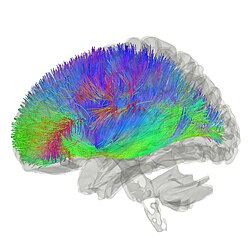Striatum: Perbedaan antara revisi
Konten dihapus Konten ditambahkan
Striatum Tag: Suntingan perangkat seluler Suntingan peramban seluler Suntingan seluler lanjutan pranala ke halaman disambiguasi |
k Box Tag: halaman dengan galat kutipan Suntingan perangkat seluler Suntingan peramban seluler Suntingan seluler lanjutan |
||
| Baris 1: | Baris 1: | ||
{{Infobox brain |
|||
| Name = Striatum |
|||
| Latin = striatum |
|||
| Image = Striatum.svg |
|||
| Caption = Striatum (warna merah) ditampilkan didalam otak<br>(pink: [[amygdala]]; biru: [[thalamus]]) |
|||
| Image2 = Corticostriatal Pathway.jpg |
|||
| Caption2 = [[Tractography]] showing corticostriatal connections |
|||
| IsPartOf = [[Basal ganglia]]<ref>{{cite web|title=Basal ganglia|url=http://braininfo.rprc.washington.edu/centraldirectory.aspx?ID=224|website=BrainInfo|access-date=16 August 2015}}</ref><br />[[Reward system]]<ref name=YAGER2015 /><ref name=TAYLOR2013>{{cite journal | authors = Taylor SB, Lewis CR, Olive MF | title = The neurocircuitry of illicit psychostimulant addiction: acute and chronic effects in humans | journal = Subst. Abuse Rehabil. | volume = 4 | pages = 29–43 | date = February 2013 | pmid = 24648786 | pmc = 3931688 | doi = 10.2147/SAR.S39684 | quote = The DS (also referred to as the caudate-putamen in primates) is associated with transitions from goal-directed to habitual drug use, due in part to its role in stimulus–response learning.<sup>28,46</sup> As described above, the initial rewarding and reinforcing effects of drugs of abuse are mediated by increases in extracellular DA in the NAc shell, and after continued drug use in the NAc core.<sup>47,48</sup> After prolonged drug use, drug-associated cues produce increases in extracellular DA levels in the DS and not in the NAc.<sup>49</sup> This lends to the notion that a shift in the relative engagement from the ventral to the dorsal striatum underlies the progression from initial, voluntary drug use to habitual and compulsive drug use.<sup>28</sup> In addition to DA, recent evidence indicates that glutamatergic transmission in the DS is important for drug-induced adaptations and plasticity within the DS.<sup>50</sup>}}</ref> |
|||
| Components = Ventral striatum<ref name=YAGER2015 /><ref name=TAYLOR2013 /><ref name=FERRE2010 /><br />Dorsal striatum<ref name=YAGER2015 /><ref name=TAYLOR2013 /><ref name=FERRE2010 /> |
|||
| Artery = |
|||
| Vein = |
|||
| System= |
|||
| Function= |
|||
| Location= |
|||
}} |
|||
'''Striatum''', atau '''corpus striatum''' (disebut juga '''nukleus striate'''), adalah [[nukleus]] (sekelompok [[neuron]]) di ganglia basalis subkortikal [[otak]] depan. Striatum adalah komponen penting dari sistem [[motorik]] dan penghargaan; menerima masukan [[glutamatergik]] dan [[dopaminergik]] dari berbagai sumber; dan berfungsi sebagai input utama ke seluruh [[ganglia basal]]. |
'''Striatum''', atau '''corpus striatum''' (disebut juga '''nukleus striate'''), adalah [[nukleus]] (sekelompok [[neuron]]) di ganglia basalis subkortikal [[otak]] depan. Striatum adalah komponen penting dari sistem [[motorik]] dan penghargaan; menerima masukan [[glutamatergik]] dan [[dopaminergik]] dari berbagai sumber; dan berfungsi sebagai input utama ke seluruh [[ganglia basal]]. |
||
Revisi per 11 Februari 2023 11.10
| Striatum | |
|---|---|
 | |
 Tractography showing corticostriatal connections | |
| Rincian | |
| Bagian dari | Basal ganglia[1] Reward system[2][3] |
| Komponen | Ventral striatum[2][3][4] Dorsal striatum[2][3][4] |
| Pengidentifikasi | |
| Bahasa Latin | striatum |
| MeSH | D003342 |
| NeuroNames | 225 |
| NeuroLex ID | birnlex_1672 |
| TA98 | A14.1.09.516 A14.1.09.515 |
| TA2 | 5559 |
| FMA | 77616 77618, 77616 |
| Daftar istilah neuroanatomi | |
Striatum, atau corpus striatum (disebut juga nukleus striate), adalah nukleus (sekelompok neuron) di ganglia basalis subkortikal otak depan. Striatum adalah komponen penting dari sistem motorik dan penghargaan; menerima masukan glutamatergik dan dopaminergik dari berbagai sumber; dan berfungsi sebagai input utama ke seluruh ganglia basal.
- ^ "Basal ganglia". BrainInfo. Diakses tanggal 16 August 2015.
- ^ a b c Kesalahan pengutipan: Tag
<ref>tidak sah; tidak ditemukan teks untuk ref bernamaYAGER2015 - ^ a b c Taylor SB, Lewis CR, Olive MF (February 2013). "The neurocircuitry of illicit psychostimulant addiction: acute and chronic effects in humans". Subst. Abuse Rehabil. 4: 29–43. doi:10.2147/SAR.S39684. PMC 3931688
 . PMID 24648786.
. PMID 24648786. The DS (also referred to as the caudate-putamen in primates) is associated with transitions from goal-directed to habitual drug use, due in part to its role in stimulus–response learning.28,46 As described above, the initial rewarding and reinforcing effects of drugs of abuse are mediated by increases in extracellular DA in the NAc shell, and after continued drug use in the NAc core.47,48 After prolonged drug use, drug-associated cues produce increases in extracellular DA levels in the DS and not in the NAc.49 This lends to the notion that a shift in the relative engagement from the ventral to the dorsal striatum underlies the progression from initial, voluntary drug use to habitual and compulsive drug use.28 In addition to DA, recent evidence indicates that glutamatergic transmission in the DS is important for drug-induced adaptations and plasticity within the DS.50
- ^ a b Kesalahan pengutipan: Tag
<ref>tidak sah; tidak ditemukan teks untuk ref bernamaFERRE2010
